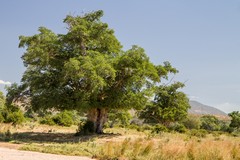
A giant fig tree on a sand river bank in
Tanzania. A large number of different species
of mammals and birds feed on the fruits and
the leaves
Figs can be found on all continents except Antarctica. There are about 900 species. In Asia as many as 70 or more species can co-exist in some forests.
Ficus is a genus of trees, shrubs and vines occupying a wide variety of ecological niches; most are evergreen, but some are deciduous. Fig species are characterized by their unique inflorescence, sometimes called a syconium, and distinctive pollination method, which uses tiny wasp species belonging to the family Agaonidae.
There are three vegetative traits that together are unique to figs. All figs possess a white to yellowish latex; the twig has paired stipules or a circular stipule scar if the stipules have fallen off; and the lateral veins at the base of the leaf are steep, forming a tight angle with the midrib and are referred to as tri-veined.
Most species are tropical and 70 per cent of the animal life in the forest depends on them. They are a “keystone” species. Birds, bats, monkeys, elephants, giraffe, insects and many more – all eat figs and in doing so disperse the seeds. Figs will also float down rivers and germinate along the strand line. Fig trees are often found along river banks. The trees fruit/flower several times a year at random. A single tree can produce up to 100,000 figs each time it fruits. Figs are very sweet and high in energy.
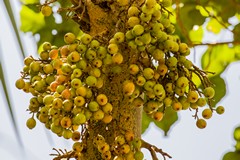
A bunch of small half ripe sycamore figs still developing
The fruits of the fig tree are the seeds within inverted flowers. The tree typically grows between 5 to 10 m tall, but some species can grow as tall as 20 m. Their abundance of leaves and fruit make them great shade trees as little sun passes through their branches. Their root system will travel beyond the reach of the branches. As of 2010, a wild fig tree in South Africa holds the record for the deepest tree roots amongst all trees with roots reaching down 400 feet.
When the unripe fruit or leaves of the tree are attacked, it floods them with latex which is foul tasting. To combat this some insects bite through the veins in the leaves to stop the flow before they start to eat a leaf.
The incredible story of fig reproduction is something which could probably never be dreamed up by a writer of fiction.
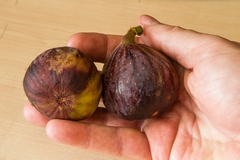
Fully ripened figs. The one one the left shows
the now sealed shut ostiole
A young female fig wasp leaves the fig tree that she was born in and searches for a fig tree in which to lay her eggs. She’s only a few millimetres long, but she will fly as far as 10 km to find a tree with 'flowering' figs, using her sense of smell to locate a fig of the exact same species. Many but not all species rely on one particular fig wasp species to pollinate them. In doing so the wasp fertilises the fig, as she loaded herself up with pollen before leaving her mother tree.
Figs don't flower in the conventional way. The fruit is the flower. The black or green orb we eat is called a syconium (from the Greek sykon, “fig”). It is what botanists call an “enclosed inflorescence” because hundreds of tiny thread-like male and female flowers grow inside the hollow fruit.
When the female finds a fig with young green figs, she squeezes through a tiny natural opening called an ostiole to get inside to the flowers. The opening is so small that when climbing in, the wasp tears her wings and antennae. This means that she will never be able to leave. She uses her ovipositor to lay her eggs in the shorter styled flowers and dies inside the tiny fig, but not before depositing some pollen, and also allowing nematode worms which infected her when she first hatched to enter the fig. The fig then creates a gall around each egg and floods the inside of the syconium with an antibacterial fluid. This allows the nematodes to swim about and reproduce.
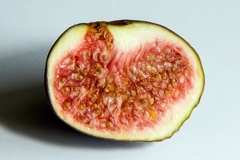
Section through a fully ripe fig showing flower
structures and seeds
Her eggs hatch and develop over the next two months, sustained by sugars produced by the tree. The young adults hatch after the fig drains the fluid from the fruit. The male wasps hatch first.
The male fig wasp is basically a penis with big jaws, size for size it's the biggest reproductive organ in the animal kingdom, several times his body length and prehensile. After hatching he crawls to a female flower with a fully developed female fig wasp inside it and bites a hole through the flower wall and then impregantes the female through the hole before she even leaves it.
After visiting several flowers he then cuts down the male flowers which are full of pollen so that the females will be able to get at them after hatching. Finally he chews a tunnel in the outer fig wall for his pregnant pollen-dusted females to escape. Males even team up to tunnel together, ensuring the females have a better chance of escape.
The female crawls out of the fertilization hole in the ovary wall initially made by the male. She deliberately collects pollen from the male flowers and packs it into a pair of little pollen baskets on the underside of her thorax before finally exiting the fig in search of a new tree to lay her eggs in. She is also infected by nematode worms at this point which start to slowly devour her from the inside out. They do not want to kill her too quickly as they need her to complete her one flight.
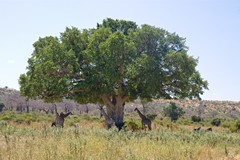
Giraffes and zebras using this huge fig tree
for shade. The browse line is at the maximum
height that the giraffes can reach
The males do not have wings, so they cannot leave, and will die inside or just outside the fig. Their adult life is a matter of a few hours only.
Figs contain an enzyme called ficin, which breaks down and essentially digests the dead wasps, absorbing them into the fruit. The fruit rapidly ripens and turns red or brown after the wasps have left.
There are also several species of non-pollinating wasps which deposit their eggs before the figs harden. These wasps act as parasites to the pollinating wasps. They don't enter the fig but have extremely long ovipositors which they use to drill through the outer wall of the fig and lay their eggs inside the fig wasps developing larvae. Their larvae then eat the fig wasp larvae. There are even parasitic wasps of the parasitic wasps who follow them around and use the same hole drilled by the parasitic wasps to lay eggs in the eggs of the parasitic wasps.
The wood of fig trees is often soft and the latex precludes its use for many purposes. It was used to make mummy caskets in Ancient Egypt. There is evidence that figs, specifically the Common Fig (F. carica) and Sycamore Fig (Ficus sycomorus), were among the first plant species that were deliberately bred for agriculture in the Middle East, starting more than 11,000 years ago.
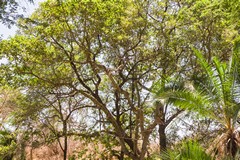
A large sycamore fig in Meru Kenya
The fig fruits, important as both food and traditional medicine, contain laxative substances, flavonoids, sugars, vitamins A and C, acids and enzymes. However, figs are skin allergens, and the latex is a serious eye irritant.
Figs are higher in fiber than any other common fruit or vegetable, and they also contain iron, calcium and potassium.
Figs are a natural mild laxative and have been used as such since the Ancient Egyptians.
The fruit has also been used as a mouth cleaner and to relieve chest congestion. The black fig pulp has been used as an ingredient in facial masks to tighten the skin. The juice from the leaves has been used on insect bites and stings, corns and warts.
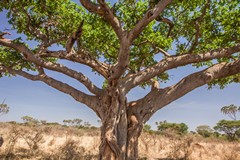
Fig tree trunks are often weird shaped and buttressed
Strangler figs are a type of parasitic fig. The seed may germinate on the branch of another tree. It grows slowly but as it does so it sends roots down around the trunk and others dangle straight down and lengthen until eventually they reach the ground. The vastly increased supply of nutrients after this happens allows the fig to grow much more quickly. Roots from the strangler grow around the host tree's trunk and thicken and fuze into a lattice. The tree can't increase its girth and the fig has a dense canopy that steals the available light. Eventually the host dies. The trunk rots and leaves a hollow cylinder of fig which is quite capable of supporting itself.